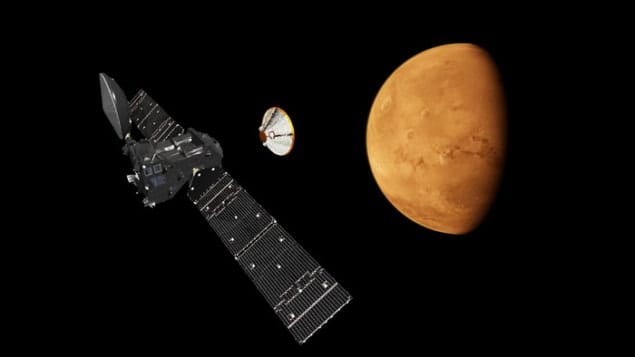
A joint European and Russian probe to study the atmosphere and surface of Mars has successfully launched today from the Baikonur Cosmodrome in Kazakhstan. The Trace Gas Orbiter (TGO) – a collaboration between the European Space Agency (ESA) and the Russian space agency Roscosmos – also includes the entry, descent and landing demonstrator module (EDM) that will test landing techniques for a future Mars rover.
When the TGO arrives at Mars following a seven-month journey, it will initially stay in a highly elliptical orbit until January 2017. ESA scientists will then use “aerobraking” – taking advantage of the planet’s atmosphere to slow the spacecraft down – to manoeuvre the TGO into a more circular orbit with an altitude of 400 km. “We do not know exactly how long aerobraking will take because this depends on how effectively we can use atmospheric drag,” Jorge Vago, project scientist for the mission, told physicsworld.com.
Researchers expect TGO’s scientific mission to begin in December 2017, when it will then operate for five years. Carrying four instruments including spectrometers, high-resolution cameras and a neutron detector, the TGO will map Mars for sources of methane, which could be evidence for possible biological or geological activity. The mission will also chart hydrogen below Mars’s surface up to a depth of around 1 m. This could, for example, reveal deposits of water-ice below the surface that could help to provide landing locations for future missions. Vago told physicsworld.com that observations with the TGO will be 1000 times better than previous missions.
Towards a Mars lander
The EDM, which is also known as Schiaparelli, will separate from the TGO three days before arriving at Mars. It will then enter the planet’s atmosphere at 21,000 km per hour and decelerate using aerobraking before deploying a parachute. Finally, it will use a thruster to brake just before landing on the surface. During landing and while it is on the surface of Mars, the EDM will monitor the pressure and temperature as well as take images. The probe is expected to last a couple of days on the surface before its battery is drained.
The EDM will be particularly useful for the next part of the joint mission between ESA and Roscosmos. The ExoMars rover, which is due to launch in 2018, will carry a drill and a suite of instruments dedicated to exobiology and geochemistry research, searching for possible signs of life, characterizing the water and geochemical distribution of the surface, and identifying any hazards for future manned missions to the planet. The EDM will be a useful testing ground for the techniques to successfully land the ExoMars rover, while the TGO will be used to communicate with the rover once it is on the surface.
When one becomes two
Getting the ExoMars project off the ground has been far from straightforward. It was initially a European-only mission that consisted of a single rover. Then following budget struggles, ESA joined forces with NASA, with the mission expanded to include an orbiter. But in 2011, due to the need to fund the James Webb Space Telescope, the US pulled out amid tight budgets. ESA then approached Roscosmos, who agreed to join the mission in 2012 with the TGO and ExoMars rover being split into two separate missions.
- Astrobiologist Lewis Dartnell of the University of Leicester explains how ExoMars will look for evidence of life on Mars in the podcast “Is there life on Mars?“



